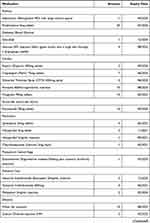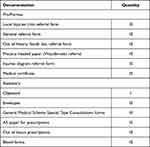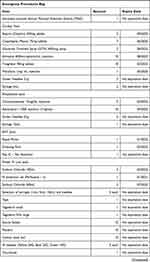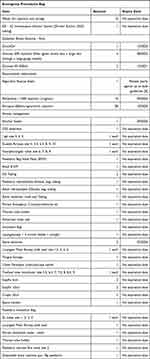Back to Journals » Clinical Audit » Volume 14
General Practice Doctors Bag and Emergency Bag Audit – A Quality Improvement Project (QIP) in a Rural Irish General Practice
Authors Hutch W , Payne B, Henderson M, Looney-Herlihy B, Tarrant S, Gillman C
Received 10 February 2022
Accepted for publication 27 June 2022
Published 7 July 2022 Volume 2022:14 Pages 41—53
DOI https://doi.org/10.2147/CA.S361304
Checked for plagiarism Yes
Review by Single anonymous peer review
Peer reviewer comments 2
Editor who approved publication: Dr Zoka Milan
Video abstract of "QIP in a Rural Irish General Practice" [ID 361304].
Views: 174
William Hutch,1 Brendan Payne,2 Mark Henderson,2 Breda Looney-Herlihy,2 Sheila Tarrant,2 Catherine Gillman2
1The Department of General Practice, University College Cork, Cork, Ireland; 2Woodbrook Family Practice, Newmarket, Co, Cork, Ireland
Correspondence: William Hutch, The Department of General Practice, University College Cork, Cork, Ireland, Tel +353 21 4632288, Email [email protected]
Background: Rural general practitioners are typically located far from secondary care. As a result, they have to be able to manage many clinical presentations. One pivotal component is the doctor’s bag and emergency bag.
Aim: To audit the doctor’s bag and emergency bag contents of suitable documentation, equipment and medications against standardised checklists. To create an online resource to monitor these contents.
Methods: A list of medications, documentation and equipment in the practice doctors’ bag and emergency bag was undertaken. This was compared to a standardised checklist. An online intervention tool, the “Ampoule App”, allowed users to identify contents and expired items for each bag. The reaudit cycle allowed for replacement of outdated items based on the apps expiration dates.
Results: The exact equipment, medications and documentation for our practice doctors’ bag and emergency bag were identified. The quantity and expiration dates of items were recorded. Fifty-eight out of 315 items had expired. These were replaced and this information was uploaded to the Ampoule App. Education and engagement with the app alerted users as to when a medication is due to expire in the future, therefore allowing adequate time to replace items.
Conclusion: There was a desirable improvement in the contents of the doctor’s bag and emergency bag post intervention using the Ampoule App and re-education. This audit has led to an increased awareness of what we as GPs carry in our bags daily and how we prepare to deal with multiple medical presentations.
Keywords: general practice, doctors bag, emergency bag, Ampoule App, audit
Introduction
We live in a world that is complex and unpredictable, where even medical experts at times struggle to optimise care. However, the simplest of techniques such as a checklist can lead to immediate improvements.1 Such checklists are implemented in hospitals around the world helping doctors and health-care workers respond to routine surgical cases to more recent global pandemics such as the covid 19.2
As general practitioners (GPs), we too can use checklists. Rural general practitioners are typically located far from secondary care. The speed at which emergency services can attend is often be limited, such as by air ambulance or by land. Also, when on duty, at weekends and nights, there is a limited number of pharmacies open and therefore, a GP should be prepared to have an adequate amount of medication on hand if required. As a result, they must be able to manage many clinical presentations from non-acute to acute care. One such method of optimising this care is dependent on the choice of equipment, documentation, and medications that they have on hand, particularly if working out of hours. One pivotal component to this is the doctor’s bag and its contents.
According to the Irish College of General Practitioners (ICGP), GPs and GP registrars “should have a fully equipped bag for use on house calls or emergency calls”.3 The ICGP highlight that the information provided for their doctor’s bag and emergency bag is advisory and such, advice is intended to be used to aid doctors in their choice of bag and equipment setup. They provide a basic template of what is included. It notes that, what is carried by each individual doctor is a matter of personal choice and will vary depending on one's needs such a rural or urban practice.
A report published by the Primary Care Quality and Information Service of Wales, 2012, outlines “what is the minimum extent and range of items that are likely to be of genuine value in providing emergency and urgent care outside the practice”.4 They stress that it needs to be practical and highlight that it must be up to date using a robust method using an inventory such as a checklist to allow for restocking. Ideally, this checklist should be easy to use so that GPs will be able to record what was used and replace items in a simple systematic manner.
It is hoped that this audit will provide useful information for both GPs and new GP registrars when reviewing the contents of their own medical bag and emergency bag. In addition, the contents of each bag are outlined including documentation, equipment and medications that are suitable for practice when on duty, with particular emphasis on practice in a rural setting.
Aims
The following aims are:
- To audit our practice doctors’ bag and emergency bag contents of suitable documentation, equipment and medications against standardised checklists so as to optimise the GP’s ability to manage urgent and non-urgent situations in a rural Irish setting.
- To create an online resource to monitor these contents. Therefore, allowing adequate time to replace items that may have expired.
Methods
This audit was undertaken at Woodbrook Family Practice, Newmarket, Co. Cork, Ireland from 01/09/19 to 01/05/2020.
This audit was exempt from review and ethical approval by the Cork General Practice Training Scheme because it was a non-interventional study (ie, an audit of the doctor’s bag and emergency bag contents only) and no subjects were involved.
Prior to starting this audit, in discussion with the practice staff, we agreed the choice of medication and equipment over a two-week period from 01/09/19 to 14/09/19 that would be most suitable to be included in a doctor’s bag and emergency bag for a rural setting. We agreed to use the Primary Care Quality and Information Service of Wales, 2012 audit as a template, along with the ICGP guidelines, and this study's guideline bag contents are reproduced in the result tables (Tables 1–4). 3,4 Based on these audits, the ideal number of bags to have is two, that is a doctors bag and a “trauma bag”/Emergency bag.
 |
Table 1 Doctors Bag and Its Contents |
 |  |  |
Table 2 Doctors Bag – Medication Inventory and Expiration Dates |
 |
Table 3 Documentation/Multi-Organiser Folder Contents |
 |  |  |  |
Table 4 Emergency Procedures Bag |
Round one of the audit (16/09/19 to 04/10/19) set out to record the current content of our doctors bag and emergency bag A systematic checklist was undertaken by each of the authors as follows:
- Cataloguing the items of equipment and medications against a standardised list.3,4
- For each medication: name of medication, quantity, and expiration dates.
- For IM injections/Ampoules quantity and expiration dates were recorded.
- Documentation– As a practice, we agreed the choice of appropriate documentation.
Round two of audit (08/10/19 to 01/03/20): The doctor’s bag and emergency bag contents were checked by two authors (WH, BP & BLH) against the standardised checklists.3,4 On review of the checklists, if ambiguity regarding inclusion/exclusion of an item, for example such as a medication like an antibiotic, the authors WH, BP and BLH consulted local guidelines before including/excluding any items5 Based on this intervention, expired items were ordered, and an up-to-date catalogue was created.
Once round two of the audit was complete, this allowed for the most up-to-date content to be upload to the “Ampoule App”. This App allows for real time monitoring for all the doctor’s bag contents. It provides a fast, easily accessible checklist that will alert the doctor when any medication expires and therefore can be replaced in time.
Results
A systematic checklist of medications and equipment in the doctor’s bag and emergency bag were recorded and the findings of round 2 of the audit is presented. Please see Tables 1–4.
The initial audit found 58 out of 315 items had expired. These items were replaced with the quantity and expiration dates included as outlined in Tables 2 and 3 as part of the reaudit cycle. This ensured that all items in the doctor’s bag and emergency bag are in date and recorded. In addition, the initial list of items was reduced to 199 items outlined above as these were chosen to be more in line with other previous studies and our needs in rural general practice.3,4
The second intervention of this reaudit cycle was to enter this data into the Ampoule App. The “Ampoule App” was downloaded to iPhone and iPad. The above information from the doctor’s bag and emergency bag was manually entered only after this reaudit cycle had been undertaken. The authors agreed that it was more suitable to manually the items into the ampoule app at this stage as once populated the app would act as an online tool to monitor the most up-to-date doctors’ bag and emergency back contents going forward. Such information was color coded based on the following: The medication/equipment, dose, and its units of measurement, whether it was a tablet, ampoule, syringe. It also included essential batch information if applicable. The expiration dates were entered, and such dates show how many days are left before expiration. All medications and equipment are up to date in the online Ampoule App and cross referenced against the hard copy above. Now both hard copies and online copies exist.
The final part of this Audit involved training practice staff on how to interpret the Ampoule App, therefore allowing them to monitor and order new medication/equipment based on expiration dates.
Discussion
This audit showed a significant improvement in the contents of the doctor’s bag and emergency bag post intervention. The implementation of such checklists as outlined in our results has led to an increased awareness of what we as GPs carry in our bags daily and how we prepare to deal with multiple medical presentations.
This audit demonstrates the importance of simple checklists in the wider care of patients for GPs. GPs are extremely hardworking, highly trained, skilled and on a daily basis deal with numerous uncertainties from multiple presentations. As a result, GPs are at higher risks of error. Avoidable failures are not just a feature of general practice but also in other areas of high complexity, for example such as the aviation industry.6,7 The reason for such avoidable errors is evident from the volume, complexity, and capacity that GPs deal with daily.6 Such failure can impact a GP's health, along with their practice and their private lives. One such strategy for overcoming failure, is to take advantage of where other industries such as the aviation industry succeeded by applying simple checklists that prepare, plan, and implement standard operating procedures.
The simple checklist from our results led to the development of this audit to optimise what we as GPs carry in our bags daily and how we are to be prepared to deal with medical uncertainties in our day-to-day working lives as GPs. Furthermore, the use and implantation of the Ampoule App and the attached hard copy checklists led to an agreed practice protocol as to what are the contents of the doctor’s bag and emergency bag for our practice in a rural setting. This can be also used for an urban GP setting.
The advantage of the audit is that it can be used to change practice at a national and international level. GPs can replicate our checklists outlined along with using the Ampoule App. This saves time recording the appropriate doctors bag and emergency bag contents while also improving reliability. Moreover, it allows GPs to have an up-to-date record of contents that can be monitored in real time.
The disadvantages are that for GPs, the doctors bag contents to date have been tedious to record and monitor. In rural settings, the doctor typically must have a large quantity of equipment and medication on hand to deal with numerous presentations. This can be very time consuming and onerous for GPs. This audit checklist findings and with the use of the online App will allow GPs to overcome this difficulty in the future. A disadvantage of the Ampoule App is that its software functionality is very basic and can be time consuming to input the data. As there is no desktop version, it took a considerable amount of time to input the data into the app. Moreover, the app did not have great versability for allowing recoding of equipment/medication per say disease type. For example, it would be beneficial to group medications under headings such as analgesia, as outlined in the results section.
Due to the app disadvantages as outlined, this led to the generation of a new idea for a future research project for the doctor’s bag. We have begun to develop an online resource (www.GPbag.ie and an app: GP bag) based on this audit, to enable GPs/GP registrars to use real-time checklists and educational material on what is required for a doctor/GP bag. This will allow them to monitor their bag contents of medications/equipment online, via a new more versatile app, with desktop compatibility. This website will be a digital resource where GPs can log into to check their equipment against other standardised virtual bags. This will also provide new GP registrars with itemised lists of medications that they may choose to carry along with equipment.
Conclusion
There was a desirable improvement in the contents of the doctor’s bag and emergency bag post intervention and re-education. This quality improvement project has led to an increased awareness of what we as GPs carry in our bags daily. Further investigations implementing this study’s doctor’s bag and emergency bag checklists, along with the ampoule app may assist GPs to optimise care from urgent to non-urgent medical presentations.
Disclosure
The authors report no conflicts of interest in this work.
References
1. Gawande A. The Checklist Manifesto. Metropolitan Books of Henry Hold and Company LLC; 2010.
2. World Health Organization. The safe surgery checklist; 2009. Available from: https://www.who.int/patientsafety/safesurgery/checklist/en/.
3. O’ Ciardha D. GP Registrar Handbook: A Guide for GP Registrars.
4. Primary Care Quality and Information Service of Wales. General medical doctors bag audit. PHW document database (primary care quality and information service); 2012. Available from https://phw.nhs.wales/services-and-teams/harp/urinary-tract-infection-uti-resources-and-tools/uti-accordian/audit-quality-improvement-tools/.
5. Health Service Executive (HSE). Antibiotic prescribing guidelines. Available form https://www.hse.ie/eng/services/list/2/gp/antibiotic-prescribing/.
6. Kapur N, Parand A, Soukup T, et al. Aviation and healthcare: a comparative review with implications for patient safety. JRSM Open. 2015;7(1):2054270415616548. doi:10.1177/2054270415616548
7. Aerden D, Smets D, Poelaert J, et al. Fighting human error: what surgeons can learn from aviators. Acta Chir Belg. 2014;114(4):228–232. doi:10.1080/00015458.2014.11681017
 © 2022 The Author(s). This work is published and licensed by Dove Medical Press Limited. The full terms of this license are available at https://www.dovepress.com/terms.php and incorporate the Creative Commons Attribution - Non Commercial (unported, v3.0) License.
By accessing the work you hereby accept the Terms. Non-commercial uses of the work are permitted without any further permission from Dove Medical Press Limited, provided the work is properly attributed. For permission for commercial use of this work, please see paragraphs 4.2 and 5 of our Terms.
© 2022 The Author(s). This work is published and licensed by Dove Medical Press Limited. The full terms of this license are available at https://www.dovepress.com/terms.php and incorporate the Creative Commons Attribution - Non Commercial (unported, v3.0) License.
By accessing the work you hereby accept the Terms. Non-commercial uses of the work are permitted without any further permission from Dove Medical Press Limited, provided the work is properly attributed. For permission for commercial use of this work, please see paragraphs 4.2 and 5 of our Terms.
